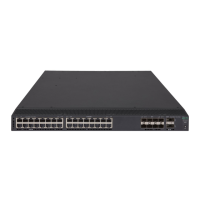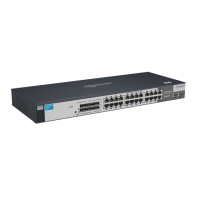141
Destinations : 5 Routes : 5
Destination/mask Protocol Preference Cost Interface
0x010000/8 FSPF 20 100 Vfc10
0xfffc01/24 DIRECT 0 0 InLoop0
0xfffffa/24 DIRECT 0 0 InLoop0
0xfffffc/24 DIRECT 0 0 InLoop0
0xfffffd/24 DIRECT 0 0 InLoop0
The output shows that an FSPF route from Switch A to Switch C exists, with the outgoing interface VFC 10.
# Display the node login information for VSAN 100.
[SwitchA] display fc login vsan 100
Interface VSAN FCID Node WWN Port WWN
Vfc1 100 0x020000 21:01:00:1b:32:a0:fa:12 21:01:00:1b:32:a0:fa:11
# Display the brief information about the name server database in VSAN 100.
[SwitchA] display fc name-service database vsan 100
VSAN 100:
FCID Type PWWN(vendor) FC4-type:feature
0x010000 0x01(N) 10:00:00:05:30:00:25:a3 SCSI-FCP:Target
0x020000 0x01(N) 21:01:00:1b:32:a0:fa:11 SCSI-FCP:Initiator
Verifying the configuration on Switch C and Switch D
Verify the configuration on Switch C and Switch D, for example, Switch C.
# Display the node login information for VSAN 100.
[SwitchC] display fc login vsan 100
Interface VSAN FCID Node WWN Port WWN
Vfc1 100 0x010000 10:00:00:05:30:00:25:a4 10:00:00:05:30:00:25:a3
FCoE configuration example (in IRF mode)
Network requirements
As shown in Figure 36:
• Switch A and Switch B are connected to an Ethernet switch, and operate at the access layer of the
LAN.
• Switch A and Switch B are connected to Switch C and Switch D, respectively.
• The four switches operate as the FCF switches of the SANs.
Configure FCoE to meet the following requirements:
• The transmission network formed by Switch A, Switch B, and the Ethernet switch can use the server
to provide services for the LAN. The transmission network formed by switches A through D can
enable the server to access the disk device.
• Link backup is used to implement high availability for the packets to and from the server and disk
device.
• The bandwidth is increased for the link between Switch A and Switch C and the link between Switch
B and Switch D. Link backup and load sharing are implemented.
